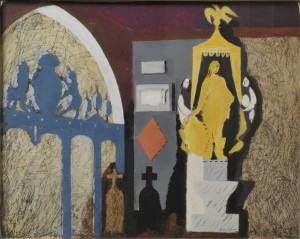In the early seventeenth century Sir John St.John of Lydiard Park, a wealthy country gentleman, employed artists of the highest calibre to create a range of Renaissance monuments to commemorate his family and celebrate their ancestry, wealth, and taste. The most notable of these is the St.John family polyptych, regarded as the most splendid monument of the kind surviving in England.
The polyptych contains eleven painted panels and began with a central panel (1615) attributed to the popular court painter, William Larkin. This life-size painting features Sir John’s departed parents, himself and his wife Anne (Leighton), and his six sisters. Sir John’s father had been knighted by Queen Elizabeth at Lydiard Tregoze in 1592, and it would have been an additional source of family pride that all his sisters made marriages befitting their rank.
The monument's huge outer doors bear heraldic tables that demonstrate the family’s pedigree, including their close ties with the royal House of Tudor. Luckily for Sir John, he had an expert genealogist on hand to prepare the family trees. His uncle Sir Richard St.George was the second most senior herald in England.
By the 1680s the family decided to repair and update the monument, to record the latest glories which had raised the social standing of the St. John family. The original heraldry was covered with new painted canvas and was only discovered during comprehensive restoration in the 1980s.
A full history of the remarkable monument is available in Curiously Painted – An illustrated history of the St. John family polyptych at Lydiard Tregoze by the late Canon Brian Carne and can be ordered via The Friends of Lydiard Park.






